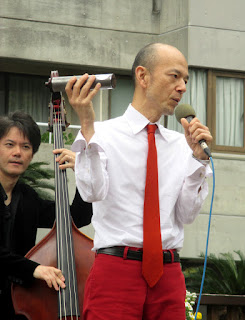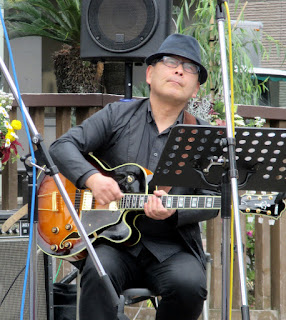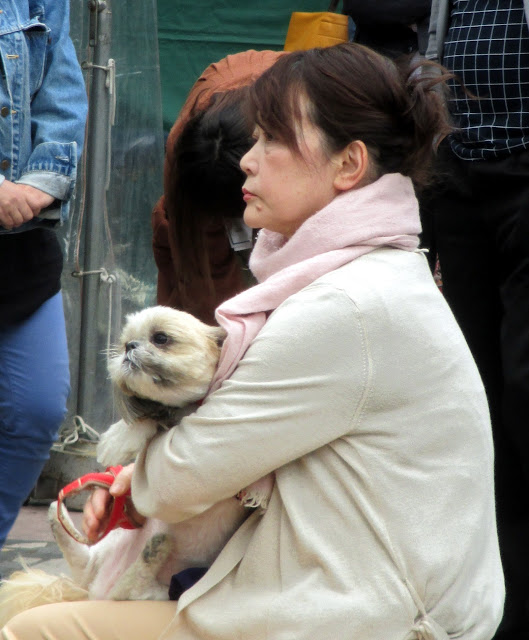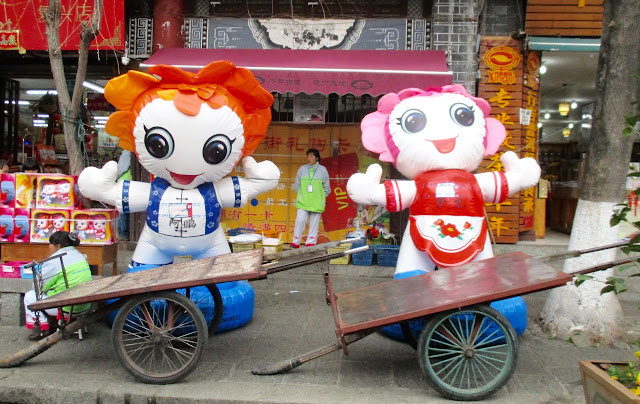 |
| a passenger tuk-tuk |
After
about a week in Dali, still not too familiar with public
transportation and unable to speak Chinese, we hired a private driver
to take us to Chongsheng Temple some 3 kilometers from Dali Old Town.
At the same time we also decided to get back to Dali on our own by
taking a tuk-tuk (a three wheeled vehicle so called by the sound it
makes when under way—tut-tuk-tuk-tuk).
 |
| the Three Pagodas of Chongsheng Temple |
We met our driver on the corner of Fuxing and Yu'er Roads and he dropped us off at the
ticket entrance to the temple and introduced us to an
English-speaking young woman who showed us through the ticket buying
and entrance procedure and where to begin exploring the huge site. We
could have taken a small tour bus, but opted to walk instead. The
young woman told us it would take about four hours on foot and that
it was all paved uphill slopes and steps. Nevertheless, we decided to
give it a try. It did take, just as she said, about four hours.
 |
| the center and largest pagoda |
 |
| The Leaning Tower of Chongsheng? |
The
most characteristic aspect of Chongsheng Temple is three original 8th
Century pagodas made of brick that have been standing for some 1200
years. The center multi-leveled pagoda is square and dominates the
other two in both size and height. The other smaller pagodas are
octagonal and shorter and seem to lean a bit, reminiscent of the
leaning tower of Pisa in Italy. In the afternoon sun the towers are
beautifully reflected in a small pond obviously placed there for that
purpose.
 |
| entrance to the temple precinct |
 |
| the portal of Chongsheng Temple |
The
temple is an enormous complex (5.68 sq.km.) dramatically backdropped by the Cangshan
range with a variety of temple buildings
dedicated to this and that Buddhist deity. It is said to be the "largest Han Buddhism temple in China". One obvious thing stands
out, all the buildings look rather new and have beautiful shiny
orange tile roofs. There are some very imposing buildings size-wise
and ornamentation-wise. Pictures can tell the story better than words
in this case. We soldiered on up tier after tier until we finally
reached the topmost temple with a 12-meter (39-foot) high statue of
the goddess Guanyin
[観音]that
I mentioned in the previous post. The
view from the temple veranda of the distant Erhai Lake and the valley
sloping down to it is marvelous.
 |
| Hall of Mahavira |
 |
| Mahavira Buddha |
 |
| DaHei - three faces, multiple arms |
 |
| incense sticks in front of Mahavira Hall |
 |
| biggest prayer wheel I ever saw |
 |
if you're going to Chongsheng Temple -
be sure to wear some flowers in your hair |
 |
wouldn't want to meet this guy
in a dark alley |
 |
| the pond of nine dragons bathing Buddha |
 |
12-meter statue of Guanjin
a.k.a. Ecuoye Avalokitesvara |
 |
| Ecuoye Avalokitesvara Pavillion |
 |
| breathtaking view from the Ecuoye Avalokitesvara Pavillion |
Most of the complex, with the exception of the three pagodas, was
deliberately destroyed during the notorious Great Proletarian
Cultural Revolution* from 1966 to 1976, but was rebuilt in the 1990s
to its present lustrous appearance. We timed our descent to catch the
setting sun on the western face of the three pagodas reflected in
their reflecting pool.

 We
were pretty dog tired by the time we clambered back down to the
parking lot although the descending was much easier than the
ascension. When we approached the parking lot there were several
tuk-tuks lined up and as we approached the driver of one of them
hailed us so we we walked up to him and (like veterans) bargained for
his tuk-tuk to take us back to Dali. The driver asked 20¥, I offered
10¥, we settled on 15¥, a little more than $2. We bumped and
tuk-tukked along until he dropped us off near West Gate and indicated
the way to walk back to the hotel. While holding up traffic we got
him to pose with me for a photo op.
We
were pretty dog tired by the time we clambered back down to the
parking lot although the descending was much easier than the
ascension. When we approached the parking lot there were several
tuk-tuks lined up and as we approached the driver of one of them
hailed us so we we walked up to him and (like veterans) bargained for
his tuk-tuk to take us back to Dali. The driver asked 20¥, I offered
10¥, we settled on 15¥, a little more than $2. We bumped and
tuk-tukked along until he dropped us off near West Gate and indicated
the way to walk back to the hotel. While holding up traffic we got
him to pose with me for a photo op.
Oh, before I forget again, about the hats. The sun was surprisingly strong in February at Dali's 2000-meter elevation above sea level (over a mile high) and after walking around the first day my face looked like a boiled lobster. So, the hats.
*
The effects of the Cultural Revolution directly or indirectly touched
essentially all of China's population. During the Cultural
Revolution, much economic activity was halted, with "revolution",
regardless of interpretation, being the primary objective of the
country. Mao
Zedong Thought
became the central operative guide to all things in China. The
authority of the Red Guards surpassed that of the army, local police
authorities, and the law in general.
In
a few years, countless ancient buildings, artifacts, antiques, books,
and paintings were destroyed by Red Guards. The status of traditional
Chinese culture and institutions within China was also severely
damaged as a result of the Cultural Revolution, and the practice of
many traditional customs weakened.
There
were however also positive outcomes for some sections of the
population, such as those in the rural areas. For example, the
radical policies ... provided many in the rural communities with
middle school education for the first time, which is thought to have
facilitated the rural economic development in the 70s and 80s.[96]
Similarly, a large number of health personnel were deployed to the
countryside as barefoot
doctors
during the Cultural Revolution. Some farmers were given informal
medical training, and health-care centers were established in rural
communities. This process led to a marked improvement in the health
and the life expectancy of the general population.[97]
from
Wikipedia
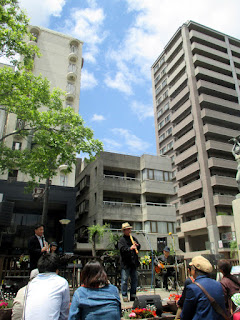 We
usually go to the local pool to do some laps on Friday
afternoon, but Road Buddy's singing teacher and his combo were on the
bill for a “jazz festival” at the river park that runs through
our city this past Friday, so we decided to go downtown and have a
look.
We
usually go to the local pool to do some laps on Friday
afternoon, but Road Buddy's singing teacher and his combo were on the
bill for a “jazz festival” at the river park that runs through
our city this past Friday, so we decided to go downtown and have a
look. Friday
was part of the so-called “Golden Week” holiday period and the
traffic going into town to find a parking spot was fairly heavy but
we found a lot with several spaces available for a reasonable parking
fee that was just a short walk from the Nishigawa river park.
Friday
was part of the so-called “Golden Week” holiday period and the
traffic going into town to find a parking spot was fairly heavy but
we found a lot with several spaces available for a reasonable parking
fee that was just a short walk from the Nishigawa river park.
 When
we arrived, the first act was already on stage and there was a small
number or spectators and passers by stopping for a few minutes and
then moving on. Probably most of the people seated were friends and
acquaintances or students of the band leader. The group, consisting
of base fiddle, keyboard and saxophone and vocalist played several
numbers including Take Five, Over the Rainbow, and The Girl from
Ipanema.
When
we arrived, the first act was already on stage and there was a small
number or spectators and passers by stopping for a few minutes and
then moving on. Probably most of the people seated were friends and
acquaintances or students of the band leader. The group, consisting
of base fiddle, keyboard and saxophone and vocalist played several
numbers including Take Five, Over the Rainbow, and The Girl from
Ipanema.
 When
we arrived, the first act was already on stage and there was a small
number or spectators and passers by stopping for a few minutes and
then moving on. Probably most of the people seated were friends and
acquaintances or students of the band leader. The group, consisting
of base fiddle, keyboard and saxophone and vocalist played several
numbers including Take Five, Over the Rainbow, and The Girl from
Ipanema.
When
we arrived, the first act was already on stage and there was a small
number or spectators and passers by stopping for a few minutes and
then moving on. Probably most of the people seated were friends and
acquaintances or students of the band leader. The group, consisting
of base fiddle, keyboard and saxophone and vocalist played several
numbers including Take Five, Over the Rainbow, and The Girl from
Ipanema.
